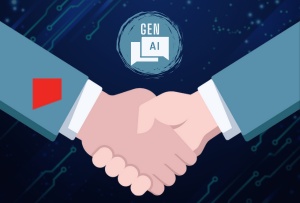When innovation meets engineering excellence, transformation happens. At Experion, we build AI-driven solutions that turn testing into a launchpad for faster, smarter software delivery.
Within the software development lifecycle, software testing has always held a key position, ensuring that applications function as expected and deliver a seamless user experience. Over the decades, the approach to testing has transformed dramatically, from manual testing performed by QA teams to script-based automated testing frameworks. While automation has accelerated testing to a great extent, the real game-changer in recent times is the adoption of Artificial Intelligence (AI) and, more specifically, Generative AI.
The introduction of AI into QA brought predictive analytics, smarter defect detection, and adaptive test execution. But Generative AI in software testing pushes the envelope further by actively generating new content, such as test cases, test data, scripts, documentation, and even comprehensive bug reports. It mimics the behavior of a skilled QA engineer, capable of analyzing requirements, inferring testing needs, and creating complete testing assets in real time.
As development cycles become shorter and expectations for quality become higher, businesses need smarter, faster, and more flexible QA solutions. This is where Generative AI promises to revolutionize QA with intelligent automation that learns, adapts, and innovates. In this blog, we will explore the mechanisms behind Generative AI in testing, its unique capabilities, the difference it brings compared to traditional AI, and how organizations can harness its full potential.
Understanding the Basics: AI in Software Testing
 Before diving into the world of generative models, it’s worth grounding ourselves in how AI is currently shaping software testing. Traditional AI has been a strong ally in identifying patterns, improving efficiency, and automating routine tasks. In testing, it’s already helping teams predict defects, suggest relevant test cases, automate executions, and analyze results with greater accuracy and speed.
Before diving into the world of generative models, it’s worth grounding ourselves in how AI is currently shaping software testing. Traditional AI has been a strong ally in identifying patterns, improving efficiency, and automating routine tasks. In testing, it’s already helping teams predict defects, suggest relevant test cases, automate executions, and analyze results with greater accuracy and speed.
Core Technologies Involved
- Machine Learning (ML)
ML algorithms are trained using historical data such as defect logs, user behavior analytics, and past test executions. These models then help identify risk-prone modules, prioritize testing efforts, and predict areas of likely failure in the code. - Natural Language Processing (NLP)
With NLP, systems can analyze and process human language effectively. In QA, it enables AI to read requirement documents, user stories, and product specifications, then automatically generate corresponding test cases or acceptance criteria. - Computer Vision
Especially relevant for UI and visual testing, computer vision techniques can detect changes in layout, design, and appearance. It ensures that visual components render correctly across different devices and resolutions.
AI’s Role Across the Testing Lifecycle
- Planning: AI assists in identifying high-risk features based on code churn, recent changes, and past defect density. It helps teams plan smarter test strategies.
- Design: Automated test design tools use AI to convert user requirements into test cases with high coverage.
- Execution: AI helps in scheduling and running tests in parallel, managing resources dynamically, and adapting to runtime conditions.
- Maintenance: AI-based self-healing mechanisms can detect changes in UI or API structures and update test scripts automatically.
- Reporting: Advanced analytics engines process test results and provide actionable insights, including potential defect root causes and areas for improvement.
What is Generative AI in Software Testing?

Generative AI is a branch of AI that can produce original content. Unlike traditional AI, which primarily identifies patterns or makes decisions based on existing data, Generative AI creates new testing artifacts from scratch.
In software testing, this means Generative AI can automatically:
- Write test cases based on product requirements
- Generate synthetic data for test environments
- Create automation scripts in different languages (like Python, Java, JavaScript)
- Write bug reports from error logs and stack traces
- Draft test documentation and release notes
A key enabler of Generative AI is the Large Language Model (LLM), such as OpenAI’s GPT, which has been trained on vast volumes of code, documentation, and natural language data. These models can understand context, infer logic, and generate precise and usable test assets.
For instance, if given a user story like “As a user, I should be able to reset my password via email,” a generative model can:
- Generate test scenarios for valid email, invalid email, expired link, reused token, etc.
- Write a Selenium script to automate the reset process
- Create corresponding test data (emails, tokens, user accounts)
- Summarize edge cases and expected outcomes
Difference Between AI and Generative AI in Software Testing
To better understand the added value of Generative AI, let’s compare it directly to traditional AI in the context of software testing:
|
Aspect |
Traditional AI | Generative AI (Gen AI) |
| Nature of Output | Analysis, predictions |
Creation of new content |
| Data Requirements | Historical data, structured input |
Natural language, context-based |
|
Example Output |
Risk-based test selection |
End-to-end test script generation |
|
Adaptability |
Learns over time from data | Can generalize and generate without explicit patterns |
| Key Use Case | Regression suite optimization |
Generating new tests, data, and reports |
In simple terms, traditional AI tells you what to test. Generative AI also tells you how to test it—and then does it for you.
How Gen AI Can Completely Automate Software Testing?
 The concept of full automation in QA has been an elusive goal for years. Even with robust frameworks like Selenium, Cypress, or Appium, teams spend significant time writing, maintaining, and interpreting tests. These tools, while powerful, still require significant manual effort in keeping tests aligned with changing requirements, user behaviors, and evolving application interfaces. Generative AI redefines this process by addressing the gaps left by traditional automation and providing a more adaptive, intelligent approach to QA.
The concept of full automation in QA has been an elusive goal for years. Even with robust frameworks like Selenium, Cypress, or Appium, teams spend significant time writing, maintaining, and interpreting tests. These tools, while powerful, still require significant manual effort in keeping tests aligned with changing requirements, user behaviors, and evolving application interfaces. Generative AI redefines this process by addressing the gaps left by traditional automation and providing a more adaptive, intelligent approach to QA.
With Gen AI, the idea isn’t just about automating the execution of predefined scripts—it’s about automating the entire test lifecycle, from test design to test optimization. This includes creating tests, adapting them in real time, intelligently analyzing failures, and evolving the test suite over time. Here’s a breakdown of how Gen AI can transform each step:
- Self-Generating Test Suites
Traditionally, writing test cases involves understanding requirements, determining input/output parameters, defining edge cases, and then scripting them manually. Not only does this process take considerable time, but it also invites mistakes. Gen AI revolutionizes this step by:
- Parsing requirement documents, user stories, and API specifications using NLP.
- Creating comprehensive test scenarios that include positive, negative, and boundary cases.
- Structuring output in formats compatible with common testing frameworks like JUnit, TestNG, and Cucumber.
- Incorporating domain-specific validations, such as financial rules or healthcare workflows.
For example, if a new feature is rolled out that allows users to schedule appointments via an app, Gen AI can instantly generate multiple test scenarios, such as double-booking prevention, notification triggers, time zone handling, and more.
- Auto-Healing Scripts
Test scripts often break due to changes in the application under test (AUT), such as updated element IDs, modified workflows, or new UI components. In traditional automation, maintaining these scripts can consume up to 30% of the total testing effort.
Gen AI addresses this by:
- Continuously monitoring test results and identifying changes in application behavior.
- Matching updated UI elements using attributes like type, context, and position.
- Automatically updating XPath or CSS selectors in test scripts.
- Logging changes for human review, ensuring transparency and traceability.
This ensures high resilience in the testing process, especially for agile teams pushing weekly or daily updates.
- Intelligent Reporting
Test logs have historically been verbose, technical, and hard to interpret, particularly for non-technical stakeholders. Gen AI enhances reporting by:
- Summarizing test execution results in plain language.
- Automatically highlighting critical failures and potential causes.
- Drafting bug reports complete with reproduction steps, environment configuration, logs, screenshots, and suggested root causes.
- Mapping defects to user stories or features for better traceability.
Imagine a scenario where a payment gateway fails during checkout. Instead of just reporting a generic “Transaction failed” message, Gen AI might report: “Payment API returned a 500 error when submitting credit card info. Likely cause: Invalid token. Occurred in Chrome v116 on Windows 10 during regression suite execution.”
- Personalized Test Data Creation
Test environments require diverse data that represents real-world usage. Manually crafting such datasets or masking production data can be both time-consuming and risky. Gen AI streamlines this process by:
- Generating synthetic yet realistic data across various domains, like finance, healthcare, and retail.
- Automatically covering edge cases, outliers, and data boundary conditions.
- Ensuring compliance with data protection regulations (e.g., GDPR, HIPAA).
- Simulating geographic, demographic, and behavioral diversity for performance and usability testing.
For instance, in testing an insurance claims portal, Gen AI could create test users across age brackets, policy types, regions, and claim histories, ensuring robust coverage and avoiding real-user data exposure.
- Continuous Test Optimization
As time passes, test suites become cluttered with redundant or outdated test cases, leading to longer execution times and lower efficiency. Gen AI enables ongoing test optimization by:
- Analyzing test execution history to identify flaky or irrelevant tests.
- Retiring tests that no longer contribute to quality assurance.
- Recommending new tests based on recently introduced application logic.
- Balancing test coverage with execution time constraints in CI/CD pipelines.
This adaptive capability ensures your test suite remains lean, effective, and aligned with product evolution. As your application grows, your tests evolve automatically.
Ultimately, Generative AI for QA testing doesn’t just reduce the time and effort associated with software testing, it fundamentally transforms the way testing is conceived, executed, and improved. By providing full-cycle automation, Gen AI makes QA teams faster, more reliable, and more strategically impactful than ever before.
Gen AI in Software Testing: Key Use Cases

Let’s look at how Gen AI is being used today:
- Enterprise SaaS: Creating comprehensive smoke, sanity, and regression test suites based on change logs.
- eCommerce Platforms: Testing dynamic user journeys across search, filters, payments, and personalized recommendations.
- Healthcare Systems: Generating test data that mimics real-world patient interactions without compromising patient privacy.
- Financial Services: Automating compliance-related test cases and audit logs generation.
- Mobile Applications: Creating cross-device test scripts to ensure compatibility across OS versions and screen sizes.
Each use case demonstrates the adaptability and context-awareness of Gen AI.
Benefits of AI and Software Testing Integration
Integrating Gen AI into QA processes delivers both tactical and strategic benefits:
- Increased Productivity: Testers shift focus from repetitive tasks to high-value exploratory testing.
- Reduced Time to Market: Faster test creation and execution speed up the release cycle.
- Improved Quality: Comprehensive and consistent coverage reduces escape defects.
- Resource Optimization: Smaller teams can test larger applications without scaling headcount.
- Compliance and Risk Management: Automated test evidence and audit trails support regulatory adherence.
At the intersection of domain expertise and AI innovation, Experion delivers QA solutions that learn, adapt, and evolve, just like the businesses we build for.
Challenges and Considerations of Gen AI in QA
With great power comes the need for responsibility:
- Test Quality Assurance: Gen AI is not immune to logic errors. Human review and test validation remain essential.
- Over-Reliance on Automation: Teams must strike a balance between automated and exploratory testing.
- Integration Complexity: Legacy systems and tools may require custom connectors or APIs.
- Ethical Concerns: Bias in training data can influence AI output, impacting fairness in applications.
- Security Risks: Generated scripts and data should be audited to avoid unintentional vulnerabilities.
Tooling and Platforms Supporting Generative AI in Software Testing
Several tools have emerged or evolved to incorporate Gen AI features:
- Testim by Tricentis: Offers AI-powered low-code test automation with auto-maintenance features.
- Mabl: Combines ML and Gen AI for intelligent test creation and execution.
- Applitools Ultrafast Grid: Uses visual AI and predictive models for UI regression.
- Diffblue: Generates unit tests for Java applications using Gen AI principles.
- OpenAI Codex, GitHub Copilot: Code generation tools increasingly support test writing and refactoring.
Custom LLM integrations using platforms like OpenAI, Anthropic, or Cohere allow organizations to tailor Gen AI to domain-specific QA needs.
Future of Software Testing with Generative AI
The journey is just beginning. Here’s what the next few years might look like:
- Test Automation as a Service: Fully AI-managed pipelines with plug-and-play testing.
- AI QA Agents: Virtual testers embedded within development teams, reviewing code and tests in real time.
- Continuous Learning Systems: Gen AI models that evolve from each test cycle and customer feedback.
- Voice-Activated QA: Conversational interfaces to generate and execute tests.
- Bias Testing and Ethical AI Assurance: Dedicated QA roles to validate fairness in AI-driven applications.
Getting Started: How to Integrate Generative AI in Your Testing Workflow
The shift to AI-driven workflows requires thoughtful preparation, cultural change, and technical readiness. Here are six essential steps to get started:
- Assess Readiness
Begin by evaluating the maturity of your existing QA practices. Do you have a robust test repository? Are your requirements documented clearly? Identify areas where repetitive tasks consume time, such as test case writing, maintenance, or defect reporting. A readiness assessment should also consider data availability, test automation coverage, and your CI/CD maturity level.
Example: If your team already uses automated unit and regression testing but spends hours generating edge-case test data, Gen AI can offer immediate value in data generation.
- Set Clear Goals
Every successful transformation starts with a defined objective. Ask what you want to improve: Is it faster test coverage? Reduced regression cycle time? Better test documentation? Establishing KPIs—like test coverage percentage, bug resolution time, or test suite execution time—will help measure the impact of your Gen AI integration.
Tip: Avoid vague objectives like “improve testing.” Instead, aim for specifics, such as “automate 60% of test case generation within three months.”
- Choose the Right Tools
Not all Gen AI tools are created equal. Select tools that:
- Integrate with your development and CI/CD ecosystem (e.g., Jenkins, GitHub, Jira)
- Support your programming languages and frameworks
- Allow extensibility and custom model training if needed
- Offer strong governance and auditability features
Tools like Testim, Mabl, or even custom GPT-powered scripts can be powerful allies depending on your specific needs.
- Train Your Team
Technology alone doesn’t guarantee success. Upskill your QA engineers in:
- Understanding AI-generated artifacts
- Prompt engineering for requirement input
- Reviewing and validating Gen AI outputs
- Using AI responsibly and ethically
This is also a good time to foster a mindset shift from “test executor” to “AI orchestrator.” Encourage curiosity and experimentation.
- Monitor and Measure
Track performance improvements, bottlenecks, and model accuracy using metrics such as:
- Time saved in test creation
- Increase in test coverage
- False positive/negative rate from AI-generated cases
- Test maintenance effort pre- and post-AI adoption
Regularly validate outputs to ensure quality, and adapt your metrics as the implementation matures.
- Iterate Continuously
Generative AI integration is an ongoing journey. Just as software evolves, so should your Gen AI implementation. Continuously refine prompts, retrain models with feedback, and update processes based on changing business needs.
Example: If a model begins producing redundant test cases, review your prompt strategies or fine-tune the model with more representative examples.
Adopting Gen AI is not a one-size-fits-all process. But with a clear strategy, proper tooling, and team readiness, you can build a future-ready QA practice that is smarter, faster, and highly scalable.
How Experion Can Offer Support in Software Testing With Generative AI?
 As enterprises embrace next-gen solutions, our role goes beyond traditional QA. We partner with businesses to integrate Generative AI into their testing workflows, unlocking faster releases, deeper insights, and greater confidence.
As enterprises embrace next-gen solutions, our role goes beyond traditional QA. We partner with businesses to integrate Generative AI into their testing workflows, unlocking faster releases, deeper insights, and greater confidence.
With a strong foundation in digital product engineering and a forward-looking mindset, we help clients build QA capabilities that are intelligent, adaptive, and scalable.
Our Gen AI-Powered QA Offerings Include:
- Tailored Test Generation Models
Leveraging LLMs trained on your product specifications, past defects, and business rules, we auto-generate high-coverage test cases across functional, integration, and regression scenarios. - Auto-Healing Test Frameworks
Our frameworks integrate seamlessly with CI/CD pipelines and are equipped to self-correct when UI elements or endpoints change, minimizing manual rework. - Context-Aware Synthetic Data Engines
We design Gen AI pipelines that produce realistic, privacy-compliant test datasets tuned to your industry’s nuances, be it healthcare, finance, or retail. - Predictive Quality Analytics Dashboards
Using AI-driven insights, our dashboards help stakeholders visualize test effectiveness, detect potential release risks early, and trace defect origin with clarity. - AI-Augmented QA Consulting
We assess your current QA maturity and craft a roadmap for gradual, measurable Gen AI adoption, from proof-of-concept to full-scale rollout. - Domain-Specific Prompt Engineering
Our experts fine-tune AI interactions to align with your product vocabulary, logic flows, and test philosophy.
Why Experion?
- Deep experience in building and scaling test automation across industries
- Proven success in applying AI/ML for quality assurance in real-world projects
- Ethical AI practices with transparency, security, and governance at the core
- A culture of innovation that ensures your QA stays ahead of the curve
Partnering with Experion means empowering your QA teams to become AI orchestrators, not just test executors. Whether you’re at the beginning of your Gen AI journey or looking to enhance an existing setup, we deliver solutions that elevate your QA into a strategic business enabler.
Conclusion
As businesses evolve in the digital age, so must their approach to quality assurance. Generative AI in Software Testing marks a shift from task automation to strategic enablement. It transforms testing into a smart, creative, and self-evolving discipline.
The road ahead will not be without challenges as model tuning, oversight, and integration effort remain critical. However, those who adopt early and integrate thoughtfully will benefit from faster releases, higher quality, and greater agility.
Experion stands ready to guide you on this journey. Let us help you unlock the next level of quality engineering with Generative AI.
Key Takeaways
- Generative AI enables automated test case creation, data generation, and defect reporting.
- It bridges the gap between human creativity and machine efficiency.
- Integration must be accompanied by governance and ethical considerations.
- The future of QA is not just automated; it’s intelligent, generative, and adaptive.
Every great product begins with great testing. At Experion, we infuse intelligence at every stage, so innovation never hits a quality ceiling. Ready to explore the future of software testing? Let Generative AI show you the way!

